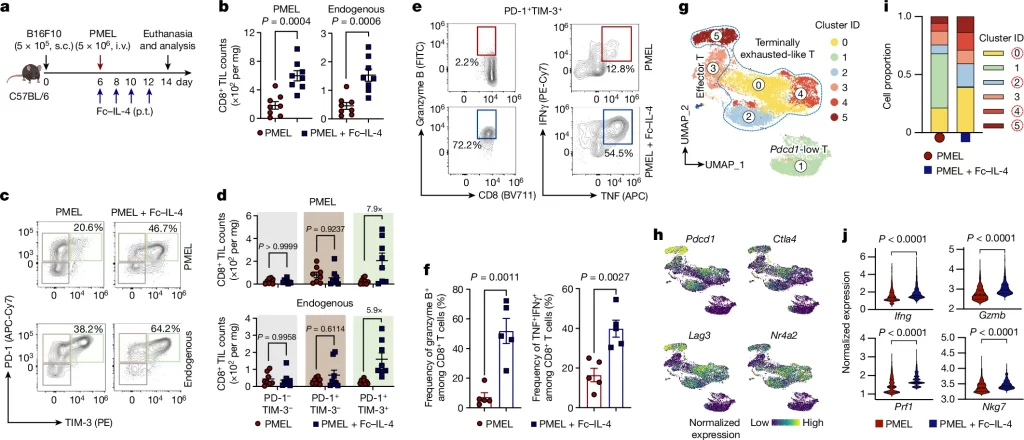type 2 cytokine Fc-IL-4는 exhausted CD8+ T cell을 활성화하여 암에 대항한다

Abstract
현재의 암 면역 요법은 주로 암과 싸우는 type 1 면역 반응을 유도하는 데 중점을 두고 있지만, 장기적인 완전 관해(complete remission)는 아직 흔하지 않다. 암에 대한 지속적인 반응을 달성하기 위해 type 1 중심 면역 요법과 함께 type 2 면역을 조율할 수 있는지에 대한 중요한 질문이 제기되고 있다. 본 연구에서는 전형적인 type 1 cytokine인 interleukin-4 fusion protein (Fc-IL-4)이 CD8+ T cell에 직접 작용하여 종양에서 기능적으로 terminally exhausted CD8+ T(CD8+ TTE) cell을 풍부하게 한다는 사실을 보여주었다. 결과적으로 Fc-IL-4는 type-1 immunity-centric adoptive T cell 이식 또는 immune checkpoint blockade 요법의 항종양 효능을 향상시키고, 여러 동종 및 이종 이식 종양 모델에서 지속적인 관해를 유도한다. 메커니즘적으로, 우리는 Fc-IL-4가 signal transducer and activator of transcription 6 (STAT6) 및 mammalian target of rapamycin (mTOR) 경로를 통해 신호를 전달하여 lactate dehydrogenase A 의존적으로 CD8+ TTE 세포의 당 분해 대사와 nicotinamide adenine dinucleotide (NAD) 농도를 증가시키는 것을 발견했다. Fc-IL-4가 매개하는 대사 조절은 종양 내 CD8+ TTE cell을 재활성화하는 데 필수적이다. 이러한 연구 결과는 암에 대한 장기적인 반응을 유도하기 위해 type 1 면역과 효과적으로 시너지 효과를 내는 강력한 type 2 cytokine 기반 면역 요법으로서 Fc-IL-4를 강조한다. 이 연구는 이 두 가지 유형의 면역 반응 간의 시너지 효과를 밝힐 뿐만 아니라, type 2 면역 인자를 통합하여 차세대 암 면역 요법을 발전시키기 위한 혁신적인 전략을 공개한다.
* terminally exhausted T cell: 면역 반응에서 지속적인 자극을 받다가 기능을 상실한 T cell. effector T cell의 특징을 유지하기 위한 전사 인자가 활성화되지 않고, 억제 수용체가 높게 발현하는 등 일시적인 탈진 상태가 아닌 완전히 기능을 상실한 상태에 가까움.
